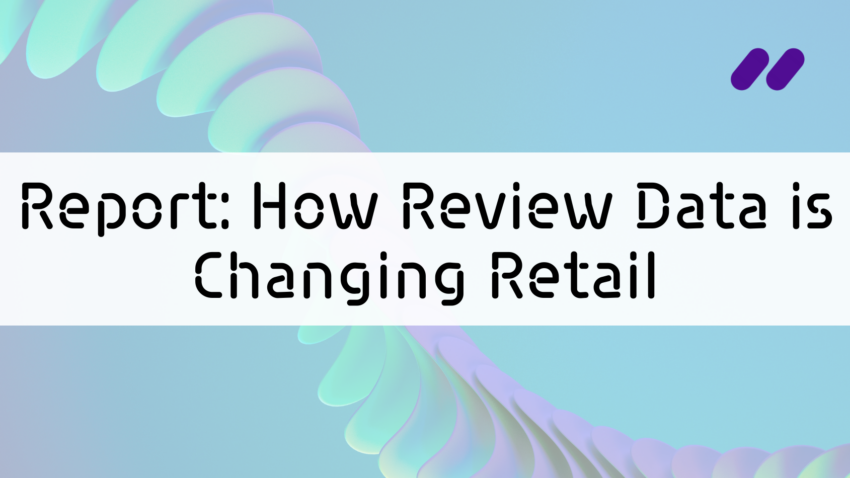Today, as more and more retail brands face a struggle for survival —shuttering their brick-and-mortar stores and losing revenue in the process—making the shift from in-store to online sales has never been so urgent and so necessary.
Even without calculating for the current pandemic upending retail on an unprecedented scale, double-digit growth YoY in the eCommerce share is set to represent 22% of USD 29 Trillion global sales by 2023—and 57% of global sales growth is expected to be driven by this increase in online purchasing. Almost overnight, brands have become reliant on online sales.
1. Review data is available—and so is the solution to higher sales
Brands that stood out as the forerunners of online sales are rushing alongside late-adopters to embrace a new mode of online marketing and selling. What does that new mode look like? It’s going where consumers are and asking where people are shopping online, how they’re weighing their purchasing decisions, and why they’re buying. This new mode of marketing and selling taps into a wealth of online consumer review data that’s already out there—and growing.
Review data shows brands what consumers are saying in their own words, without lag time and without the biased prompting of surveys that many consumers won’t answer—only 19-26% of buying customers who receive surveys from retail companies respond to them. Consumers’ sudden reliance on online shopping coupled with a decrease in people’s trust in advertising (83% don’t trust advertisements) means brands can’t afford to not be in control of their reviews and those reviews’ value to marketing.
Sophisticated AI customer feedback management solutions put review data front and centre as a marketing channel for community management and consumer insights. Those insights directly and accurately inform marketers so they can craft a customized e-commerce environment tailored to engagement, conversions and high sales. Are retail brands ready for this transition today? The reviews are out there waiting for brands to make a move towards stronger, sales-driving connections with their customers. Equipped with the ability to analyze reviews through an AI solution, brands can leverage each and every customer review today.
2. Where data fits into retail industry challenges
Right now it is imperative for brands to connect with consumers online and engage them in purchasing. In 2018, online reputation management was already a priority for 97% of retail businesses. Now, online marketing and sales is everyone’s priority.
Customers are now being hit with more advertising, email blasts, pop-up deals and other brand marketing in every facet of their online lives. With all that noise, it’s more difficult than ever for marketing to get their message through. And even then, is the customer listening?
The retail industry’s embrace of digital avenues and big data has led to more personalized and customizable marketing strategies that make use of, for example, real-time recommendations for customers as they online shop and human-like chatbots that support customers in decision-making and purchasing.
Yet even with these advances some things remain the same: people still buy on emotion and justify with logic. Emotional decision-making has its own, personal logic and richly diverse context. Today, marketers who understand this are tapping into new data-driven ways to emotionally connect with customers and implementing an unprecedented level of personalization in their marketing strategies.
3. Inside the customer feedback gold mine
As online sales rocket, so do online reviews. Detailed, varied and unsolicited, this customer feedback comes from both satisfied and unsatisfied customers, who openly share their opinions about products and their buying experiences, often explaining exactly why they suited them or didn’t.
In reviews, customers don’t only talk about products, they talk about how these products fit into their lives. In essence, they talk about who they are—from simple likes and dislikes to lifestyle preferences. Looked at individually and in targeted groupings, these reviews provide reasons for purchasing, repurchasing or dissatisfaction while also providing an even more valuable emotional, psychological context for other consumers and for marketers.
Feedback is not a goldmine of information for information’s sake; it’s a goldmine because customer reviews impact buying decisions. A goldmine because it describes habits, routines, lifestyles and preferences. That form of feedback is the kind that makes a significant difference when converting customers and maintaining customer loyalty.
Every piece of feedback is a business opportunity
Customers regard brands and even their related companies as more than manufacturers or service providers: they form value-based and emotional relationships with them. Customer feedback has become an integral part of that relationship, with hundreds of thousands of customers sharing their thoughts in reviews on multiple public websites.
- 91% of people regularly or occasionally read online reviews, while 84% of those people trust reviews as much as a personal recommendation.
- 95% of consumers are influenced by online reviews for their purchase.
- A +0.1 star rating can increase conversion rates by +25%.
- A brand with excellent reviews can experience a +31% spend increase.
- More than four negative reviews about a company, brand or product can decrease sales by 70%.
Today, people relate to reviews to connect with the reality of a brand and its products—they’re on the search for other people’s opinions, from how they use products to what they think about the brand itself. They’re also looking to see if brand promises really do come true: 55% of consumers believe the best way retailers can build trust is to “deliver what they promised,” while 67% won’t buy if they find out brands don’t live up to their promises. In the process of reading and writing reviews, consumers are making an emotional, trust-based connection with each other around a public conversation about brands.
Considering the high impact of reviews on conversion rates, strategic marketing campaigns and advertising may be in vain without a comprehensive and accurate way to manage and leverage customer feedback.
4. Why review data should lead marketing strategies today
A 2019 Forrester whitepaper found that the way customers think and feel predicts how they act—this finding empowers brands to understand the “why” behind business outcomes. Since every consumer decision is motivated by emotion, then emotional connection is the most effective way to connect and build trust with customers.
Customers reviews are as effective as word-of-mouth
The fact is, though some customers writing reviews want brands to listen to them, many more are using reviews to speak to their peers about how they think and feel about products. People want to hear from each other about their lived experiences with products—and people trust each other more than they trust brands and their products.
These online reviews should be understood as peer-to-peer conversations and valued for the insight they can provide to marketers. In online reviews, people reveal their realities, from their wants and needs to their everyday struggles.
So it’s no surprise that so many customers consult reviews before making a purchase. Reviews provide a form of peer-to-peer guidance. The information in reviews is perceived by consumers as less biased and more trustworthy than a brand’s advertising.
Currently, 83% of customers don’t trust advertising and most of those customers choose to pay attention to—and trust—other customers’ peer reviews online:
- 94% of consumers trust social media influencers more than a friend for their purchase.
- 74% of consumers rely on recommendations shared by influencers for their purchase.
- 73% of consumers think written reviews are more important than star and number ratings.
On top of that, consumer conversion rates also increase when brands themselves engage with online reviews. A brand that responds to 32% of customer reviews may see 80% higher conversion rates than a similar sized brand replying to 10% of reviews.
All contextual review data can drive conversion rates
All reviews, and especially negative reviews, have the capacity to increase conversion once their data is taken into account. In reviews, customers justify their likes and dislikes of products, adding valuable personal context to their reasoning.
Every review can represent a potential sale—it’s all about context. Even a negative review can be understood as a positive: when one person writes, “This face cream makes my oily skin even oilier!” a consumer who is looking for a product to moisturize their dry skin might just add the face cream to their online shopping cart.
Catching those nuances of contextual detail in reviews is where a feedback management solution makes all the difference to understanding customers and what makes them buy. AI feedback analysis speeds up and focuses this process in a situation such as today’s, where time is of the essence.
Beyond analyzing customers’ online reviews, a fast and effective AI customer feedback solution solves retail brands’ short-term needs for connecting with customers in a time of rapid change to the retail sector, with its channel shift from in-store sales to online purchasing. In the longer term, AI data analysis helps companies readily adapt to future changes in the retail sphere, letting a brand keep conversion rates up while other players try to weather the storm.
5. How public, freely available review data connects brands to customers
The massive surge of digital data in the expanded online retail sector has resulted in a wealth of information about who’s buying what brands are selling and why. While the goldmine of customer feedback is out there, the sheer amount of it can seem overwhelming to even the most seasoned marketing strategist.
The volume of unsolicited feedback is a double-edged sword for brands: both a new opportunity to get to know and connect with customers and a challenge in managing customer expectations and ensuring that their requests and problems are satisfactorily addressed.
However, looked at through the lens of AI data management, that feedback is all opportunity. Sophisticated AI text-analytics provides insights to take advantage of opportunities and resolve challenges via a data-driven marketing strategy. Those thousands of reviews that once seemed inaccessible and overwhelming will launch brands towards greater engagement, increased sales and brand growth.
Under the hood: Why does text analytics matter for deeper customer insights?
Because it powers sophisticated feedback management solutions.
AI text analytics might seem like some kind of abstract, complex technology, but fundamentally it serves as the engine behind Keatext’s powerful customer feedback management solution.
Here are just a few things it allows brands to do:
- Uncover the meat and nuanced sentiment behind customer reviews.
- Massively expand feedback analysis capacity to thousands of data points per minute.
- Continuously gather data about customer sentiment at multiple points throughout a product’s lifecycle, including pre and post-product launch.
- Monitor, reply and engage with negative feedback in real time.
- Understand and anticipate upcoming trends and pain points before they impact a brand’s reputation and identity.
Data for today’s strategies and the long term
AI data analysis is a key business development tool for staying in immediate and lifelong touch with customers’ needs and behaviours. When applied to publicly available product reviews, data analysis opens the door for brands to tap into customer preferences and purchasing behaviour as they change with global news and trends.
The outcome of applying AI text analytics to these reviews is undeniably powerful: a precise identification of consumers’ needs, wants and motivations. The challenge is to use the available data to sell products and services so a brand can increase revenue and sustain consumer relationships.
The most popular tools today for understanding customers, such as web analytics tools, focus on quantitative data. On the other hand, customer feedback from online reviews is a mix of quantitative and qualitative data, with the emphasis on unstructured, qualitative data that is submitted with little to no prompting by marketers.
Data gathered through expensive approaches such as surveys provide relatively small datasets to analyze, whereas millions of online customer reviews can be accessed and analyzed quickly thanks to AI’s Natural Language understanding technologies. These online reviews still provide qualitative first-person data on consumers yet can be analyzed as massive data sets to reveal the personal, emotion -based logic of decision-making and purchasing.
Best AI practices in marketing
- Embrace customer feedback, especially negative feedback—this data provides valuable insights on customers behaviours and pinpoints what resonates most with them.
- Identify points in the customer journey where a company can gather and analyze customer data sets, such as reviews and other feedback.
- Combine small data with big data’s broader metrics and insights to boost the success of marketing strategies and link them to a company’s bottom line.
6. Move into the future of retail with AI analysis
With new integrated digital technologies and advances in online purchasing platforms, the retail sector continues to change rapidly. For many retail industry players, this change is serving as an inspiration for finding innovative ways of doing business.
Digital data has opened multiple windows into the complex arena of customer needs and behaviors. As a tool that can take a brand’s retail marketing strategy from being a response to industry trends to being a trendsetter, a comprehensive AI customer feedback solution stands out as the most advanced, future-oriented choice. With data-driven insights, brands can accurately and confidently strategize for higher sales and brand growth.


